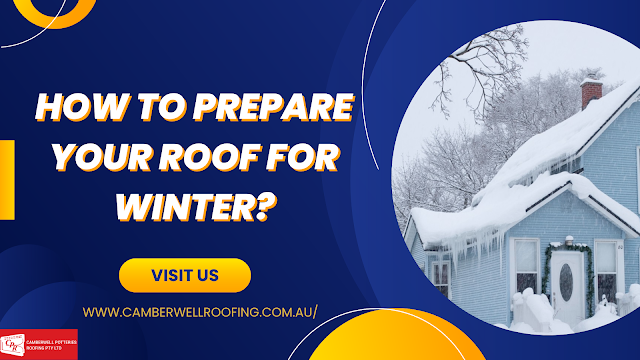How To Prepare Your Roof For Winter?
Winter approaches with changing leaves and lower temperatures. Before a snowstorm, you bring out your snow boots and rake the leaves to get your house and family ready for winter.
However, winterizing your roof should be your priority.
Anyone who has lived in Melbourne is aware that the winter season lasts for at least three months and is marked by low temperatures, overcast skies, wind, and rain.
You could be in for a difficult winter if you still need to prepare your roof. Repairing and servicing your roof is the first and most important step in winterizing your roof. So, call roofers Melbourne for a thorough inspection and repair.
Proof your roof for winter with the following checklist:
1. Trim the trees
In the summer, trees and other plants may enhance the visual appeal of your home. However, in the winter, the same trees may become rather dangerous.
The trees could accumulate snow throughout the winter. There is a danger that any branches on the weak or overhung trees will break under the weight of the snow. It may hit your roof and cause a break-in.
Your family and your property will stay safe during the winter by trimming back the greenery around your home and preventing incidents of this nature.
2. Clean your gutters
Although nobody likes doing it, you must maintain your gutters clear. Winter brings a lot of frosts, and you should prepare your gutters to handle it.
You run the danger of having flooded gutters that might allow water to seep into your property if leaves and debris clog your gutters.
This advice also holds true in the summer. Allowing leaves, twigs, and garden debris to clog your gutters poses a significant fire risk.
Trim any shrubs, trees, or other vegetation that dangle over your gutters as well. This will prevent your gutters from clogging up so frequently in the future.
3. Check for rust
Keep an eye out for any corroded portions while you clean your gutters. The fact that rusted gutters will not protect you during a major storm or prolonged amount of rain is something that many people overlook.
So, if you let your gutters rust, they will not be able to carry rainfall from your roof to the drain, which might result in leaks.
4. Insulate your home
The new roof Melbourne comes with roof insulation. However, older roofs might not have this feature. Even if they have, it might not be properly maintained.
Your home has inadequate insulation if you frequently notice that it seems colder than usual, especially during the winter.
If this is the case, heat will leak from your loft or attic, melting the snow covering the roof. Then, the melted snow will descend to your gutter, where it will eventually freeze in large quantities. Hence, it will put structural stress on the gutter and perhaps result in damage.
So, insulation ensures that your loft loses the least heat possible and makes your house safer for the environment.
5. Remove debris
Examine the surface of your roof in detail. Leftover debris will readily store moisture from winter rains. This is dangerous because moist material can grow mould and decay, which might cause damage to your roof.
If you can ascend to your roof and remove the debris, do so. Clear the roof surface of any dirt with a sweep, keeping it as spotless as possible.
Whether you can do it on your own or not, hiring roofers Melbourne is advised for the greatest outcomes. These experts are qualified, well-trained, and equipped with the expertise and tools.
6. Shingle repair
You must pay close attention to the quality of your roof's shingles, ideally before winter sets in.
Did you know that shingles may disintegrate much more quickly when snow and ice are present? Moreover, if your roof is old, it will probably start to wear out. Therefore, making sure they are in excellent health is crucial.
It might be tempting to ignore the occasional loose shingle. However, it will be far better for your roof if you fix it right away rather than risk replacing the whole thing.
7. Are there any damp spots?
You should contact roofers Melbourne as soon as possible if any wet patches appear on the inside ceiling of your home. This is a symptom that your roof needs repair since it leaks someplace.
You will ultimately have internal damage if untreated, which can be quite expensive to repair.
8. Check roof flashing
Flashing is one of the essential elements of your roof that aids in stopping leaks. There is a fair possibility that you may sustain significant water damage if your roof's flashing is damaged.
Flashing is often constructed of durable materials like galvanised metal or aluminium. This improves the safety that is essential for steering rainwater off your roof.
9. Check your roofline
Any indications of dipping, curling, or sagging in your roof lines—which should be straight—require more investigation. Problems with the framework or a wet roof deck can result in a drooping roofline.
Roofs face heavy snowfall and rain throughout the winter, which can strain the roof, worsen drooping, and even cause a cave-in.
A sinking roof is not immediately dangerous and is probably structurally sound on its own. However, a repair can be required if a leak or other deteriorating symptoms also accompany it.
Conclusion
Winterizing your roof will save a tonne of money you would have otherwise spent on repairs and heating. Additionally, it aids in preventing potentially harmful incidents like structural damage. So, call roofers Melbourne to inspect your roof for any damage.
After ensuring your roof is completely winter-ready, you can relax and enjoy staying warm and cosy in your house.


Comments
Post a Comment